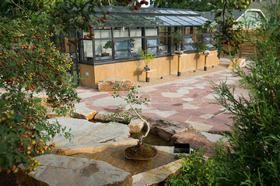


Denver Botanic Gardens Gardens Navigator Bill Hosokawa Bonsai Pavilion Tour |
All Tours


|

By Larry Jackel, Bonsai Specialist
The Bill Hosokawa Bonsai Pavilion opened on June 20, 2012. Between that date and the present, we have seen the bonsai collection grow and the landscape of the Pavilion mature, in some cases being replaced by native “character trees” of the Front Range. Plantings of Colorado blue spruce (Picea pungens) in the plant beds along the east edge of the main display area are the newest additions. As you enter the Bonsai Pavilion through the east gate, immediately to your right is a newly installed ponderosa pine (Pinus ponderosa) that will be styled to resemble an old mountain tree. To your left is a waterfall and pool, on either side of which are two Colorado blue spruce (Picea pungens) that give a feeling of old, rugged trees that have struggled and survived many years in the mountains. Directly in front of the display house are three pedestals featuring bonsai of the Front Range, but these species are not your typical bonsai material. Non-traditional bonsai material is being used with the idea to expand our concept of bonsai. These plants are succulents, a plant group that is gaining popularity as bonsai, and include species from the genera Crassula, Adenium and Fockea. They flourish at this location, the hottest spot in the Bonsai Pavilion. At your right is the bronze bust of Bill Hosokawa, the namesake of the Bonsai Pavilion. We are honored to celebrate the legacy created by Mr. Hosokawa by displaying the art of bonsai, which he admired. During the warmer seasons, a small vegetable garden, which was Mr. Hosokawa’s passion, can be seen growing at the base of his bust. Immediately to the left of the Hosokawa bronze are several display shelves, inserted in the lathe wall to display small to medium-sized bonsai. By turning back to the west, you may enter the display house. In the display house are tropical and sub-tropicals that need some protection from the dry winds and intense light of the Rocky Mountain region. Included in the Tropical Collection are willow leaf fig (Ficus salicaria), Chinese banyan (Ficus microcarpa), elephant bush (Portulacaria afra) and bougainvillea (Bougainvillea glabra). Exit the display house from the north door, take an immediate left and enter the courtyard gallery. Surrounded by Western red cedar and lodgepole pine fencing, view the core of Denver Botanic Gardens’ bonsai collection, the Rocky Mountain Collection. In this area are ponderosa pine (Pinus ponderosa), Colorado blue spruce (Picea pungens), quaking aspen (Populus tremuloides), limber pine (Pinus flexilis) and Douglas-fir (Pseudotsuga menziesii var. glauca). Many other species seen in the Front Range have been added to the collection and are on display. Each of the trees on display has a small label with a description of the tree. Some of our visitors' most frequently asked questions are about the information on these labels. “Years of training” tells us how long the bonsai artist has worked with the plant to make and maintain it as a bonsai. Another frequent question is how old are these trees? “Approximate age” is the artist’s best guess as to how old he or she thinks the plant may be, with emphasis on the word “guess.” The guess may be wrong, but it is interesting to see a bonsai that may have begun growing 250 years ago in a narrow crack in the granite of the Front Range before finding its way into a bonsai pot! As the seasons change, please stop by and see how the bonsai change -- spring growth, summer maturity, fall color and winter silhouettes -- as we continue to grow and develop this collection. | |
| Map Help |

© Denver Botanic Gardens, 1007 York Street, Denver, CO 80206
Photography © Denver Botanic Gardens

Powered by
